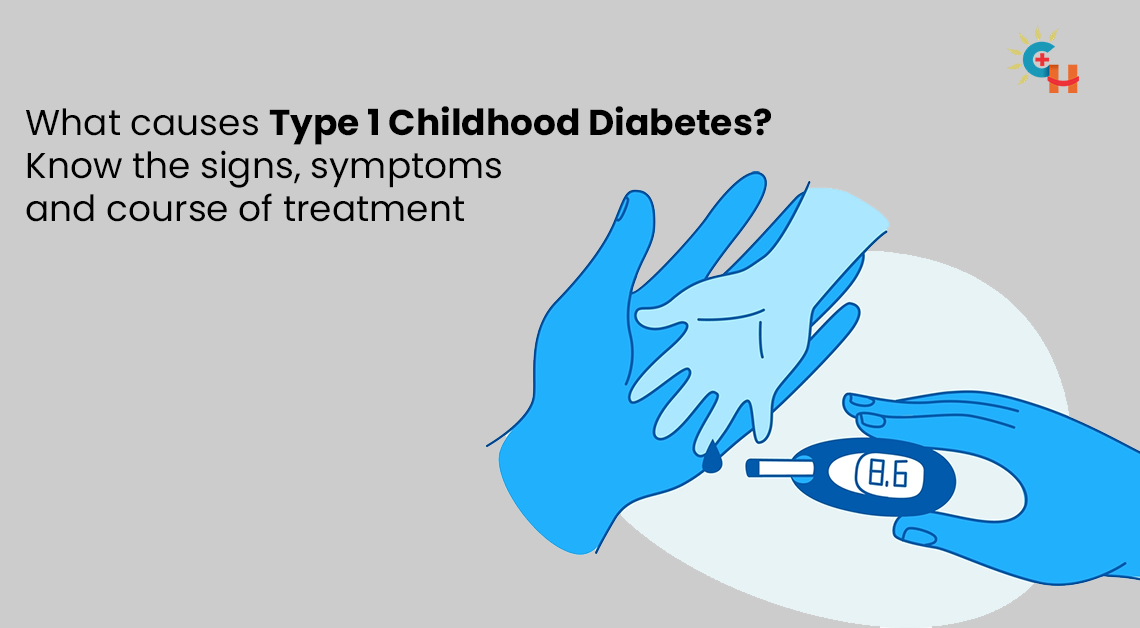Type 1 diabetes, also known as juvenile diabetes or diabetes mellitus, is a chronic autoimmune disease in which your pancreas produces little or no insulin. The pancreas is an endocrine gland that controls the amount of sugar in your bloodstream by producing insulin. It also aids in digestion by converting carbohydrates in our food into glucose, which is then pumped into our bloodstream. The glucose is subsequently used as fuel by our cells to power all the functions.
Our cells cannot operate without insulin because of the glucose shortage. Since insulin is a crucial enzyme in our body, its shortage could be dangerous for our body to function properly, especially for children.
When a child is diagnosed with type 1 diabetes, it can be stressful, especially at the initial stage. It could come as a shock and the recovery procedure could be a little difficult, so let’s learn more about type 1 childhood diabetes, its diagnosis, and treatment.
What is Type 1 Diabetes?
Type 1 diabetes is a state of illness in which the body’s immune system destroys insulin-making cells in your pancreas. It is also characterized as the body’s inability to produce insulin. This is caused by a condition when the beta cells in the pancreas are destroyed, which further leads to a reduction in insulin production. In the majority of cases in childhood, Diabetes is type 1 diabetes and lives on a lifetime dependence on exogenous insulin. Type 1 diabetes in childhood and adolescence is also known as juvenile diabetes or insulin-dependent diabetes. This is because the patient or the child suffering from Type 1 diabetes need insulin injections or insulin pumps to recover.
Childhood diabetes type 2 is similar to type 1, but in this case, your beta cells are destroyed by something other than your immune systems, such as a disease or an injury to your pancreas.
Signs and Symptoms of Childhood Diabetes type 1
The signs of disease could sometimes be subtle, but they can become severe. The early warning signs of childhood diabetes Type 1 are easy to observe and if diagnosed on time, could be treated.
The early signs of childhood diabetes are:
- Fatigue
- Weight loss
- Thirst or dehydration
- Excessive hunger
- Nausea and upset stomach
- The extreme urge to pee
- Dry mouth
- Blurred vision
- Heavy breathing
- Infections in the skin, urinary tract, or vaginal area
- irritability or mood swings
- Stomach ache
- Shaking and confusion
Diagnosis of Type 1 Diabetes in Childhood
If you observe any of the above-mentioned symptoms in your child, immediately seek a doctor’s consultation for a childhood diabetes diagnosis. Your doctor, if they suspect type 1 diabetes, will check your blood sugar level. The childhood diabetes test is conducted to test if an individual is suffering from Type 1 or Type 2 diabetes. The doctor might even take urine samples, to test the level of glucose produced in case of insulin deficiency in the body.
Type 1 Diabetes Treatment
Type 1 diabetes patients can live long and healthy lives if they follow their doctor’s prescriptions and recommendations properly. Firstly, you need to monitor your child’s blood sugar level timely. The doctor will tell you the level where the results should stick within. As needed, make adjustments to the insulin, food, and activities, to maintain or recover the blood sugar level.
Apart from this, Insulin shots are required for every type 1 diabetic patient to keep their blood sugar under control. There are different types of insulin that are available for patients with type 1 diabetes, which should be taken only under doctors’ prescription and supervision.
The majority of insulin comes in a vial, which is a little glass bottle. This is used with the help of a syringe with a needle on the end to draw the liquid out and inject it into the body as a shot. Some models of insulin shots have a pre-filled pen as well. And the last model of inulin shot is inhaled. It comes in the form of a pump that you wear and this pump injects the insulin in the body via a tube. A doctor’s assistance is necessary for determining the optimal type and delivery technique for the body.
Risk Factors For Childhood Diabetes Type 1
Early childhood diabetes has many risks and complications associated with it, this includes:
Family history – Anyone who has a parent or sibling suffering from type 1 diabetes is at a slightly higher chance of having it.
Genetics – Certain genes have higher chances of type 1 diabetes
Viruses – The autoimmune destruction of islet cells may be triggered by exposure to different viruses. For example – enteroviruses.
Preventing Type 1 Diabetes in Childhood
There is presently no known way to prevent type 1 diabetes, although researchers are working on it. While there is no concrete solution for childhood diabetes prevention, you can still help your child to avoid complications by following these guidelines.
- You can help your child in maintaining healthy blood sugar levels.
- Help and teach your child to consume a healthy and balanced diet and engage in physical activities like exercise, yoga, meditation, etc.
- Conduct a monthly health checkup for your child, and an eye test on a yearly basis.
Conclusion
Treatment of Type 1 diabetes in children is necessary, and what is most important is knowing the right way to do it. Remember, every treatment begins from home. Your doctor will help you in the treatment, but only you can help your child to maintain good health. Introduce some lifestyle changes and help your child in maintaining the blood sugar level by taking necessary precautions.


